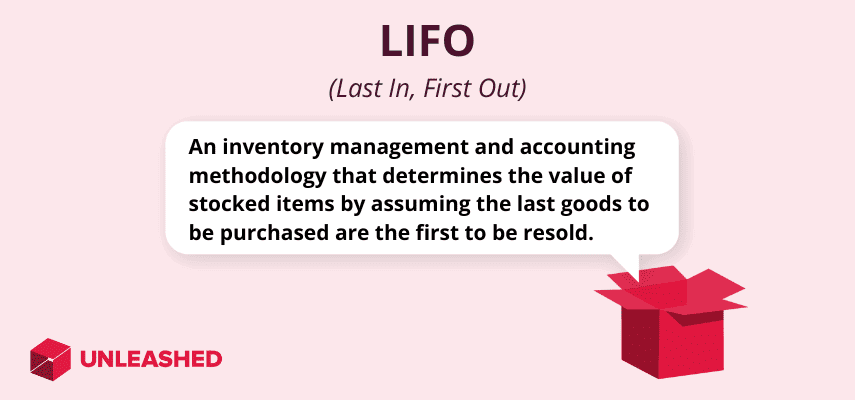
LIFO (last-in, first-out) is a method used by businesses to measure and account for the value of inventory goods. Although it can be a practical way of managing your inventory, there are many countries in which the practice of LIFO is banned.
This article explains what the LIFO costing method is, the advantages and disadvantages of using it, and examples of LIFO being applied to real-life scenarios. Let’s jump in.
What is LIFO?
LIFO is an inventory accounting method used by businesses to value their available inventory stock. It follows the rule that states the most recently acquired or produced items are the first to be sold or used. This means that the cost of goods sold (COGS) on your income statement reflects the cost of the most recent inventory purchases.

How the LIFO method works
The LIFO method means that when calculating the cost of goods sold, the cost of the most recent inventory purchases is matched against revenue first, while older inventory costs remain on the balance sheet.
LIFO is often used in periods of rising prices because it typically results in higher costs of goods sold and lower taxable income compared to other inventory valuation strategies, such as the FIFO (first-in, first-out) method.
While LIFO can offer tax advantages in inflationary environments, it can also lead to distorted inventory valuation and financial statements – especially during periods of fluctuating prices.
It’s estimated that inventory distortion (the combined cost of lost sales from out-of-stock issues and the discounts required to sell overstocks) causes around $1.1 trillion of loss worldwide each year.
FIFO vs LIFO
LIFO and FIFO are two common methods used to value inventory in accounting.
Here’s a quick summary of the differences:
- LIFO: The most recently acquired or produced inventory items are considered the first ones to be sold or used. This means that the COGS reflects the most recent costs of inventory, while older, lower-cost inventory remains on the balance sheet. LIFO is often used in periods of rising prices because it tends to result in higher COGS and lower taxable income.
- FIFO: This method assumes the oldest inventory items are sold or used first. This means that the cost of goods sold reflects the earliest costs of inventory, while more recent inventory costs remain in the balance sheet. FIFO is often preferred in stable or falling price environments because it results in lower COGS and higher reported profits.
Each method has implications for financial reporting, tax obligations, and inventory management. Businesses must carefully consider their specific circumstances when choosing between LIFO and FIFO.
Is LIFO legal in my country?
Countries and companies that operate under the International Financial Reporting Standards (IFRS) are only permitted to use the first-in, first-out (FIFO) method. This includes the United Kingdom, Australia, and New Zealand.
In the United States, the LIFO method of inventory reporting is allowed under the US Generally Accepted Accounting Principles (GAAP). This means businesses can choose one of three ways to report cash flow assumptions for inventory: LIFO, FIFO, or the average cost method.
Why is LIFO banned by IFRS?
LIFO is prohibited by the IFRS because it can misrepresent a business’s financial statements – particularly its income statement and balance sheet.
One of the main reasons for this ‘ban’ is the concern that LIFO can result in the understatement of income taxes in periods of inflation. By assuming that the oldest, cheaper inventory items are sold first, the COGS reported on the income statement may be lower. This leads to higher net income and lower taxable income. As a result, businesses can gain tax advantages that don't reflect the economic reality of the business.
LIFO can also distort the valuation of inventory on the balance sheet. Since the cost of goods sold reflects the cost of the most recently acquired inventory items, the value of the remaining inventory on the balance sheet may not accurately represent the current market value of inventory.
Overall, the IFRS aims for transparency and comparability in financial reporting, and LIFO's potential to skew financial statements goes against these principles. Thus, it is prohibited under international standards.

Calculating cost of goods sold with LIFO
Calculating the cost of goods sold using the LIFO method involves matching the cost of the most recent inventory purchases against revenue.
Here's how to calculate COGS with LIFO in five easy steps:
- Identify the most recent inventory purchases: Determine which inventory items were acquired or produced most recently. These are the items that will be considered first for sale or use.
- Track sales and inventory usage: Keep a record of the units sold or used throughout the accounting period. This includes tracking the quantity and cost of inventory items sold to customers or used in production.
- Assign costs to sold units: When a sale occurs, assign the cost of the most recent inventory purchases to the units sold. Start by allocating the cost of the latest purchases against revenue until all units sold are accounted for.
- Calculate total COGS: Sum up the costs assigned to the units sold during the accounting period. This total represents the COGS for the period under the LIFO method.
- Update inventory values: Adjust the remaining inventory balance to reflect the costs of the older inventory items that were not sold or used. These costs remain on the balance sheet until future sales or usage occur.
LIFO example
Let’s run through a simple example to illustrate how the LIFO inventory valuation method can be applied to a business.
Imagine you run a small retail store that sells electronic gadgets.
At the beginning of the year, your store had 100 units of a particular smartphone model in stock, which you purchased at $300 per unit. This makes your total opening inventory value $30,000.
In March, you purchase 50 more units of the same smartphone model at $320 per unit ($16,000 total). In June, you purchase an additional 100 units at $340 per unit ($34,000 total). In September, you purchase 100 units at $350 per unit ($35,000 total).
As the year progresses, you sell a total of 250 smartphones to customers.
To calculate your cost of goods sold using the LIFO method, you start by assuming that the most recent purchases are the first ones to be sold. So when you sell smartphones throughout the year, you match the sales with the costs of the units purchased most recently.
Let's say by the end of the year you've sold 250 smartphones.
Under the LIFO method:
- The first 100 units sold would be from your September purchase, valued at $350 each.
- The next 100 units sold would be from your June purchase, valued at $340 each.
- The remaining 50 units sold would be from your March purchase, valued at $320 each.
The table below shows how your electronic store would use LIFO in comparison to FIFO.
|
FIFO |
LIFO |
|
|---|---|---|
|
Opening inventory |
$30,000 |
$30,000 |
|
Total annual cost of inventory |
$115,000 |
$115,000 |
|
COGS |
$63,000 (initial, cheaper inventory sold first) |
$85,000 (last in, more expensive inventory sold first) |
Advantages of LIFO
The LIFO method offers several advantages for businesses, particularly in certain economic environments. These include:
- Tax benefits: LIFO can provide tax advantages, especially during periods of inflation or rising prices. By matching the most recent, higher costs of inventory with revenue, businesses can reduce their taxable income and potentially lower their tax liabilities.
- Realistic inventory valuation: In environments where prices are increasing, LIFO can result in a more realistic valuation of inventory. Since the most recent costs are allocated to COGS, the remaining inventory on the balance sheet reflects current market prices more accurately.
- Cash flow management: LIFO can help manage cash flow by reducing reported profits and tax obligations. This allows businesses to retain more cash for reinvestment, expansion, or other operational needs.
- Higher COGS: LIFO typically results in a higher cost of goods sold compared to other inventory valuation methods like FIFO. This higher COGS can better match revenue with the current costs of production or acquisition.
- Inventory turnover management: LIFO can assist in managing inventory turnover by ensuring that older inventory items, which may have lower market values, remain in stock. This can help prevent inventory obsolescence and reduce the risk of losses due to declining market prices.
- Risk hedging: In industries where raw material prices are volatile, LIFO can act as a hedge against cost increases. By expending the latest, higher-cost inventory first, businesses can mitigate the impact of rising material costs on their profitability.
Disadvantages of LIFO
The disadvantages of LIFO highlight the complexities and limitations associated with this inventory valuation method, which is why it’s important for businesses to carefully evaluate its suitability based on their specific circumstances and market conditions.
The disadvantages of LIFO include:
- Distorted financial statements: LIFO can misrepresent financial statements, particularly during periods of inflation or rising prices. It may result in lower reported profits and inventory values compared to other valuation methods, which can misrepresent the financial health of a business.
- Inventory liquidation risk: During times of declining prices or inventory shortages, using LIFO can lead to inventory liquidation issues. Selling off older, lower-cost inventory can artificially inflate profits and may not reflect the true economic reality of the business.
- Higher tax liability in stable or falling price environments: While LIFO provides tax advantages in inflationary environments, it can lead to higher tax liabilities when prices are stable or falling. This is because it matches higher recent costs against revenue, resulting in lower profits and higher taxable income.
- Complexity in inventory management: LIFO requires meticulous record-keeping and inventory tracking to accurately account for the flow of goods. Managing LIFO inventory can be more complex and time-consuming compared to other valuation methods like FIFO or average cost.
- Potential for inventory obsolescence: LIFO may increase the risk of inventory obsolescence since older inventory items – which are typically lower-cost – remain in stock for longer periods. This can result in losses if inventory becomes obsolete or loses value due to changes in technology or market demand.

Using inventory management software – LIFO vs average cost
Using inventory management software, businesses can calculate inventory using the LIFO method, or average cost.
To calculate inventory costs using the LIFO method, inventory management software tracks the costs of the most recent inventory purchases and matches them against revenue first.
The software records the dates and costs of inventory purchases, and when items are sold or used, it assigns the costs of the most recent purchases to determine the cost of goods sold (COGS). This process ensures that the most recent costs are accounted for first, reflecting the LIFO principle.
For the average cost method, inventory management systems calculate the average cost per unit of inventory based on the total cost of inventory purchases and the total number of units in stock.
It divides the total cost by the total number of units to determine the average cost per unit. When items are sold or used, the software applies this average cost to calculate the cost of goods sold (COGS) for those units.
